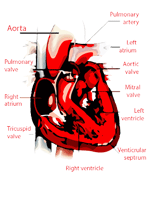Pulmonary valve stenosis
Pulmonary valve stenosis increases the resistance of output work, increases pressure in the right ventricular and limits the amount of blood flow in the lungs. While there is no shunt, arterial oxygen saturation of blood is normal, but advanced pulmonary valve stenosis cause’s peripheral cyanosis and in that way reduce cardiac output. In a healthy heart pulmonary valve is consists of three connected leafs. With every heartbeat valve is opening to let blood flow towards the lungs and then closes, not allowing the blood to return back to the right heart ventricle.
Pulmonary valve stenosis is when one or more leafs may be defective or thickening in the development or not adequately separated. Because of that, valve does not open fully and obstructs the blood flow. Pulmonary artery stenosis is an obstruction at the level of the right ventricular outflow tract and is relatively common congenital heart deformity. Constriction can be be localized to subvalvular level, at the level of the pulmonary artery and valve subvalvular and may represent a more localized combinations. Pulmonary valve stenosis is the most common form of isolated outflow tract obstruction of the right ventricle. Pulmonary valve stenosis occur in a complex interaction of genetic factors and environmental elements. It is rare to find the cause of congenital cardiac malformations such as, for example, maternal rubella or chronically excessive abuse of alcohol in the mother during embryogenesis. Various factors such as hypoxia, ionizing radiation, certain drugs have teratogenic effects. The risk of pulmonary valve stenosis in children of parents with congenital heart malformation is low, 2-5%, and would not need to be an obstacle in the planning of the offspring.
The clinical picture of pulmonary valve stenosis
Symptoms and signs of pulmonary valve stenosis
In mild cases of pulmonary valve stenosis (if the pressure gradient between the right ventricle pulmonary artery is less than 50 mm Hg) patients are asymptomatic. In moderate and severe pulmonary valve stenosis (if the gradient exceeds 80 mm Hg) there is a dyspnea during fatiguing (without heart failure). Dizziness, pain in the chest and the right ventricular hypertrophy occurs in severe cases and it is accompanied by edema, increased dyspnea and fatigue. In the second and third intercostal space to the left of the sternum there is a prominent thrill and clear harsh systolic murmur. Infundibular stenosis in the presence of murmur is heard in the third and fourth intercostales space. In severe cases, because of the heart murmurs, the second tone is unclear.
Pulmonary component is reduced, prolonged or absent. Both components can be heard in the middle severe cases. There is also pronounced presystoles heart rhythm and pronounced “a” wave in the venous pulse, in severe cases.
Symptoms depend on the degree of narrowing of the pulmonary artery valve. Patients with mild pulmonary valve stenosis usually do not have symptoms and the disease usually does not show significant progress in the course of life. More severe pulmonary valve stenosis prevents a corresponding increase in cardiac output during physical exertion and soon coming to the appearance of fatigue, dyspnea (shortness of breath) and may lead to the occurrence of syncope (transient loss of consciousness).
There may be opening and communication between the right atrium and left atrium at the level of the foramen ovale. Severe pulmonary valve stenosis is manifested at birth, recalling on clinical pulmonary valve atresia with severe cyanosis and acute heart failure which develops after the closure of the ductus arteriosus. Transition of blood, with an insufficient amount of oxygen from the right to left atrium to the systemic circulation, leads to cyanosis. Like all congenital heart defects, and this one slows down growth, increasing of body weight of the child.
X-ray examinations and fluoroscopy of pulmonary valve stenosis
Size of the heart can be normal. However, depending on the severity of disease right ventricular and atrium of the heart can be increased or very large. The pulmonary artery is dilated with weak or absent pulsations in the case of pulmonary valve stenosis, whereas the normal pulsations in infundibular stenosis. Pulmonary vascularization is normal or reduced in severe cases pulmonary valves. In this way it is possible to determine whether the pulmonary valve stenosis infundibularis type is present and together with “dye dilution” curve can confirm the presence or absence of associated shunts. Angiography describes the anatomy of the defect, including the right ventricular infundibulum.
ECG of pulmonary valve stenosis
Electrical axis deviation to right or right ventricular hypertrophy, prominent P wave.
With cardiac catheterization is possible to determine the pressure gradient as the tip of the catheter pass pulmonary valves.
Treatment for pulmonary valve stenosis
Balloon valvuloplasty is technique that is used in heart catheterization. After the vein is punctured in the groin region, catheter reaches the right ventricle where he release contrast liquid to visualizes place of pulmonary valve stenosis. The wire pass the place of pulmonary valve stenosis, then catheter is placed on a wire and and with him the pressure is measured above and below of pulmonary valve stenosis. After that, by using this wire, surgeon pulls over the catheter with inflatable balloon, which is positioned exactly at the place of stenosis. When the balloon is inflated, he extends stenosis, and frees the flow of blood.
Pulmonary valve stenosis with evident progressing hypertrophy and gradient through 75-80 mm Hg can be treated with surgery, with low operative mortality and excellent results in most cases. Defect should be corrected under the direct control of the eye. Those defects that have a strong hypertrophy of outflow tract should be corrected through the hole in the right ventricle.
Prognosis for pulmonary valve stenosis
Patients with moderate stenosis can have a normal life. Bacterial endocarditis can be developed. With moderate pulmonary valve stenosis systolic pressure in the right ventricle often remains constant for several years, that is most likely because of an increase of the pulmonary valve opening as the child grows. On the other hand in a number of children systolic pressure in the right ventricle substantially increases, which possibly can be caused by a relative reduction in the valve opening and by obstruction of the right ventricular outflow tract as a result of hypertrophy.
Advanced stenosis can lead to heart failure, especially in the twenties and thirties. Patient with mild pulmonary valve stenosis can be asymptomatic in childhood, but symptoms of the heart failure including heart decompensation, became more pronounced in later years. In mild pulmonary valve stenosis systolic blood pressure in the right ventricle increases very little and almost have no impact on the openings of right ventricle. With aging systolic blood pressure in the right ventricle is usually normal or slightly elevated.
That is why functionality of the right ventricle is practically not affected and prognosis is very positive. Only 12% of patients can survive 50 years of age. In the case of pulmonary valve stenosis, bacterial endocarditis occurs in 1% of cases a year.
You may also like:
- The Blalock Taussig shunt
The Blalock Taussig shunt is a temporary surgical operation that is performed on newborn babies. The Blalock Taussig shunt is done when the heart is not delivering enough blood enriched with oxygen to the rest of the body.
- Glenn shunt procedure and bidirectional Glenn shunt surgery
Glenn shunt is a temporary treatment that is applied on children (preceding the Fontan procedure) to improve blood flow to the lungs.
- Fontan procedure
The Fontan procedure is an open heart surgical procedure used in children with a defect in the structure of the heart and great vessels which are present at birth.



